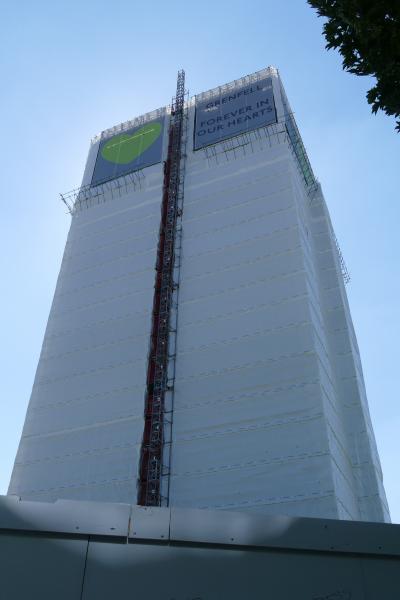Grenfell: Human Rights and a Ban on Combustible Cladding?
This blogpost looks at human rights issues related to the broader regulatory context concerning the use of flammable materials on external walls in England. It is crossposted in part with permission at the Oxford Human Rights Hub.
Posted:
Time to read:
A number of key human rights issues arise following the Grenfell Tower Tragedy in which 72 people died, and many more were displaced. In December 2017, the Equality and Human Rights Commission launched a project, ‘Following Grenfell: The Human Rights and Equality Dimension’, exploring the role that the Grenfell Inquiry plays in discharging the UK’s obligations under Article 2 of the EHRC to investigate state responsibility for the death of the victims in the Grenfell Tower fire.

Although some other countries also have problems with the particular type of cladding known in England as ACM cladding, in many countries this type of construction was simply not allowed. Hundreds of high-rise blocks of flats (and many commercial buildings) have been found to have cladding and insulation that has failed the post-Grenfell fire safety tests. Some of these residential blocks are social housing, owned by local authorities or housing associations; others are private blocks. In the social sector, remediation has begun for the majority of buildings, but in the private sector this remediation work has started on only a tiny number of blocks.
For those where cladding and insulation has been removed, the removal has caused further serious risks: cold, damp and mould, as explained in a Fuel Poverty Action briefing. For those where the cladding remains in place, what makes them ‘safe’ in the eyes of the Fire Brigade is that there are fire marshals employed 24/7 (at great cost), whose job is to alert residents in the event of fire so that they can evacuate. These are buildings often with only one stairwell, not designed for evacuation but instead intended to be operated under a ‘stay put’ policy (on the basis that the fire would not spread between floors but would be contained by the fire breaks). Of course, what this means is that thousands of people, many elderly and vulnerable, are living in blocks which could go up in flames – knowing that their homes could be lost, and worrying about whether evacuation will really work to keep them safe. And what has caused the problem is that the regulatory system intended to ensure that homes are safe when built has quite clearly failed.
The approach under the current Building Regulations 2010 (as amended) is that external walls on buildings over 18m must ‘adequately resist’ fire spread, and that to satisfy this they can either use ‘limited combustibility’ materials or, when tested as a system, pass the relevant British Standard test (BS 8414). Against that background, and following the Hackitt review, the UK government began a consultation on banning the use of combustible materials in the external walls of high-rise residential buildings in June 2018. This consultation has now closed. The Government noted that concerns had been raised about whether the BS 8414 test is satisfactory. More straightforward, it said, would be a ban on using combustible materials. The consultation states that the government ‘is minded . . . to include a specific ban’ on the use of combustible materials in residential buildings 18m or over, and that this would apply to the entire height of the wall (not only above the 18m mark). This ban would not, however, apply to existing buildings.
The Equality and Human Rights Commission responded to the Government consultation. It agrees with the proposed ban, but argues that it should go further, particularly to protect those living in existing buildings. It argues that many of the systemic failings that led to Grenfell still exist, leading to a violation of the Government’s Article 2 obligations to protect lives where there is a known risk (also discussed in my earlier blogpost). These failures apply not only to residential buildings but also schools, leisure centres and hospitals. The Commission also state that there must be urgent action to remove unsafe cladding from existing buildings.
__________
How to cite this blog post (Harvard style)
Bright, S. (2018). Grenfell: Human Rights and a Ban on Combustible Cladding?. Available at: https://www.law.ox.ac.uk/housing-after-grenfell/blog/2018/09/grenfell-human-rights-and-ban-combustible-cladding (Accessed [date]).
Share:
